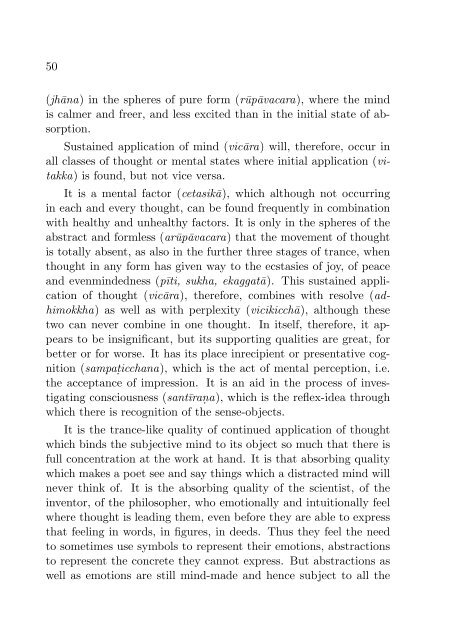Agony and Ecstasy
A comparative study of the five hindrances, together with the five states of concentration or mental absorption.
A comparative study of the five hindrances, together with the five states of concentration or mental absorption.
Create successful ePaper yourself
Turn your PDF publications into a flip-book with our unique Google optimized e-Paper software.
50<br />
(jhāna) in the spheres of pure form (rūpāvacara), where the mind<br />
is calmer <strong>and</strong> freer, <strong>and</strong> less excited than in the initial state of absorption.<br />
Sustained application of mind (vicāra) will, therefore, occur in<br />
all classes of thought or mental states where initial application (vitakka)<br />
is found, but not vice versa.<br />
It is a mental factor (cetasikā), which although not occurring<br />
in each <strong>and</strong> every thought, can be found frequently in combination<br />
with healthy <strong>and</strong> unhealthy factors. It is only in the spheres of the<br />
abstract <strong>and</strong> formless (arūpāvacara) that the movement of thought<br />
is totally absent, as also in the further three stages of trance, when<br />
thought in any form has given way to the ecstasies of joy, of peace<br />
<strong>and</strong> evenmindedness (pīti, sukha, ekaggatā). This sustained application<br />
of thought (vicāra), therefore, combines with resolve (adhimokkha)<br />
as well as with perplexity (vicikicchā), although these<br />
two can never combine in one thought. In itself, therefore, it appears<br />
to be insignificant, but its supporting qualities are great, for<br />
better or for worse. It has its place inrecipient or presentative cognition<br />
(sampaṭicchana), which is the act of mental perception, i.e.<br />
the acceptance of impression. It is an aid in the process of investigating<br />
consciousness (santīraṇa), which is the reflex-idea through<br />
which there is recognition of the sense-objects.<br />
It is the trance-like quality of continued application of thought<br />
which binds the subjective mind to its object so much that there is<br />
full concentration at the work at h<strong>and</strong>. It is that absorbing quality<br />
which makes a poet see <strong>and</strong> say things which a distracted mind will<br />
never think of. It is the absorbing quality of the scientist, of the<br />
inventor, of the philosopher, who emotionally <strong>and</strong> intuitionally feel<br />
where thought is leading them, even before they are able to express<br />
that feeling in words, in figures, in deeds. Thus they feel the need<br />
to sometimes use symbols to represent their emotions, abstractions<br />
to represent the concrete they cannot express. But abstractions as<br />
well as emotions are still mind-made <strong>and</strong> hence subject to all the

















